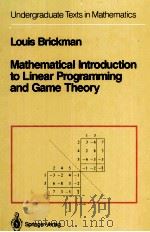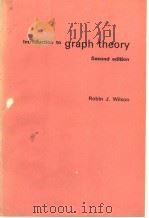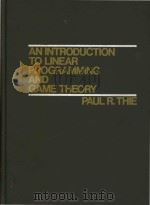《GAMES AND INFORMATION AN INTRODUCTION TO GAME THEORY SECOND EDITION》
| 作者 | ERIC RASMUSEN 编者 |
|---|---|
| 出版 | BLACKWELL |
| 参考页数 | 478 |
| 出版时间 | 1989(求助前请核对) 目录预览 |
| ISBN号 | 1557865027 — 求助条款 |
| PDF编号 | 813621168(仅供预览,未存储实际文件) |
| 求助格式 | 扫描PDF(若分多册发行,每次仅能受理1册) |

Introduction1
History1
Game Theory’s Method2
Exemp2
fying Theory2
This Book’s Style4
Notes6
PART Ⅰ GAME THEORY7
1 The Rules of the Game9
1.1 Basic Definitions9
1.2 Dominant Strategies:The Prisoner’s Dilemma16
1.3 Iterated Dominance:Battle of Bismarck Sea19
1.4 Nash Equilibrium:Boxed Pigs,Battle of the Sexes,and Ranked Coordination22
1.5 Focal Points28
Notes29
Problems32
2 Information35
2.1 Strategic and Extensive Forms of a Game35
2.2 Information Sets40
2.3 Perfect,Certain,Symmetric,and Complete Information45
2.4 The Harsanyi Transformation and Bayesian Games48
2.5 Example:The Png Settlement Game57
Notes62
Problems63
3 Mixed and Continuous Strategies67
3.1 Mixed Strategies: The Welfare Game67
3.2 Chicken, The War of Attrition, and Correlated Strategies72
3.3 Mixed Strategies with General Parameters and N Players: The Civic Duty Game77
3.4 Randomizing versus Mixing: The Auditing Game81
3.5 Continuous Strategies: The Cournot Game83
Notes86
Problems89
4 Dynamic Games with Symmetric Information93
4.1 Subgame Perfectness93
4.2 An Example of Perfectness: Entry Deterrence I96
4.3 Credible Threats, Sunk Costs, and the Open-Set Problem in the Game of Nuisance Suits98
4.4 Recoordination of Pareto-Dominant Equilibria in Subgames:Pareto Perfection106
4.5 Discounting108
4.6 Evolutionary Equilibrium: The Hawk-Dove Game110
Notes115
Problems116
5 Reputation and Repeated Games with Symmetric Information121
5.1 Finitely Repeated Games and the Chainstore Paradox121
5.2 Infinitely Repeated Games, Minimax Punishments and the Folk Theorem123
5.3 Reputation: The One-Sided Prisoner’s Dilemma129
5.4 Product Quality in an Infinitely Repeated Game131
5.5 Markov Equilibria and Overlapping Generations in the Game of Customer Switching Costs135
Notes137
Problems140
6 Dynamic Games with Asymmetric Information143
6.1 Perfect Bayesian Equilibrium: Entry Deterrence Ⅱ and Ⅲ143
6.2 Refining Perfect Bayesian Equilibrium: The PhD Admissions Game148
6.3 The Importance of Common Knowledge: Entry Deterrence Ⅳ and Ⅴ152
6.4 Incomplete Information in the Repeated Prisoner’s Dilemma:The Gang of Four Model154
6.5 The Axelrod Tournament156
Notes158
Problems159
PART Ⅱ ASYMMETRIC INFORMATION163
7 Moral Hazard: Hidden Actions165
7.1 Categories of Asymmetric Information Models165
7.2 A Principal-Agent Model: The Production Game169
7.3 Finding Optimal Contracts:The Three-Step Procedure and the Incentive Compatibility and Participation Constraints175
7.4 Optimal Contracts:The Broadway Game177
7.5 State-Space Diagrams:Insurance Games I and Ⅱ182
Notes187
Problems191
8 Topics in Moral Hazard195
8.1 Pooling versus Separating Equilibria and the Revelation Principle195
8.2 An Example of Moral Hazard with Hidden Knowledge:The Salesman Game199
8.3 Renegotiation of Contracts:The Repossession Game203
8.4 Efficiency Wages206
8.5 Tournaments207
8.6 Institutions and Agency Problems209
8.7 Teams213
Notes216
Problems219
9 Adverse Selection223
9.1 Introduction:Production Game ⅦII223
9.2 Adverse Selection under Certainty:Lemons I and II224
9.3 Heterogeneous Tastes:Lemons III and IⅣ228
9.4 Adverse Selection under Uncertainty:Insurance Game Ⅲ231
9.5 Other Equilibrium Concepts:Wilson Equilibrium and Reactive Equilibrium235
9.6 The Groves Mechanism237
9.7 A Variety of Applications239
Notes242
Problems245
10 Signalling249
10.1 The Informed Player Moves First:Signalling249
10.2 Variants on the Signalling Model of Education253
10.3 General Comments on Signalling in Education257
10.4 The Informed Player Moves Second:Screening259
10.5 Two Signals:The Game of Underpricing New Stock Issues265
Notes269
Problems270
PART Ⅲ APPLICATIONS273
11 Bargaining275
11.1 The Basic Bargaining Problem:Splitting a Pie275
11.2 The Nash Bargaining Solution276
11.3 Alternating Offers over Finite Time279
11.4 Alternating Offers over Infinite Time281
11.5 Incomplete Information284
Notes289
Problems290
12 Auctions293
12.1 Auction Classification and Private-Value Strategies293
12.2 Comparing Auction Rules298
12.3 Common-Value Auctions and the Winner’s Curse300
12.4 Information in Common-Value Auctions303
Notes304
Problems306
13 Pricing309
13.1 Quantities as Strategies: Cournot Equilibrium Revisited309
13.2 Prices as Strategies: Bertrand Equilibrium314
13.3 Location Models319
13.4 Comparative Statics and Supermodular Games325
13.5 Durable Monopoly330
Notes335
Problems338
14 Entry341
14.1 Innovation and Patent Races341
14.2 Signal Jamming348
14.3 Predatory Pricing: The Kreps-Wilson Model352
14.4 Entry for Buyout355
Notes359
15 The New Industrial Organization361
15.1 Credit and the Age of the Firm: The Diamond Model361
15.2 Takeovers and Greenmail364
15.3 Market Microstructure369
15.4 Rate of Return Regulation and Government Procurement373
Appendix A: Answers to Odd-Numbered Problems381
Appendix B: Mathematics429
Notation429
Glossary433
Risk436
Supermodularity439
References and Name Index441
Index443
1989《GAMES AND INFORMATION AN INTRODUCTION TO GAME THEORY SECOND EDITION》由于是年代较久的资料都绝版了,几乎不可能购买到实物。如果大家为了学习确实需要,可向博主求助其电子版PDF文件(由ERIC RASMUSEN 1989 BLACKWELL 出版的版本) 。对合法合规的求助,我会当即受理并将下载地址发送给你。
高度相关资料
-

- AN INTRODUCTION TO PARASITOLOGY SECOND EDITION
- 1967 EDWARD ARNOLD
-

- INTRODUCTION TO FIELD THEORY SECOND EDITION
- 1982 CAMBRIDGE UNIVERSITY PRESS
-

- AN INTRODUCTION TO THE THEORY OF SEISMOLOGY SECOND EDITION
- 1953 AT THE UNIVERSITY PRESS
-

- AN INTRODUCTION TO COMPUTERS AND INFORMATION PROCESSING SECOND EDITION
- 1985年 JOHN WILEY & SONS
-

- AN INTRODUCTION TO MONEY AND BANKING SECOND EDITION
- 1975 The Dryden Press
-

- AN INTRODUCTION TO PARASITOLOGY SECOND EDITION
- 1979 UNIVERSITY PARK PRESS
-

- AN INTRODUCTION TO EVIDENCE SECOND EDITION
- 1956 SWEET & MAXWELL
-

- AN INTRODUCTION TO MACROMOLECULES SECOND EDITION
- 1972 SPRINGER-VERLAG NEW YORK INC
-

- AN INTRODUCTION TO EPIDEMIOLOGY SECOND EDITION
- 1998 JONES AND BARTLETT PUBLISHERS
-

- MATHEMATICAL INTRODUCTION TO LINEAR PROGRAMMING AND GAME THEORY
- 1989 SPRINGER-VERLAG NEW YORK INC.
-

- AN INTRODUCTION TO MODERN POLITICAL THEORY SECOND EDITION
- 1989 ST.MARTIN'S PRESS
提示:百度云已更名为百度网盘(百度盘),天翼云盘、微盘下载地址……暂未提供。➥ PDF文字可复制化或转WORD



